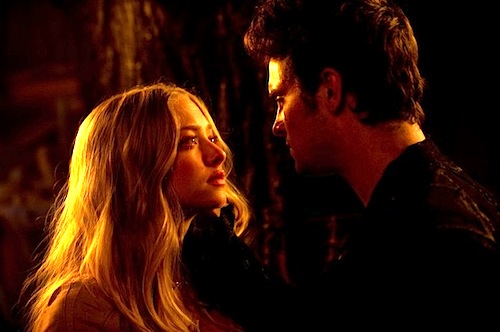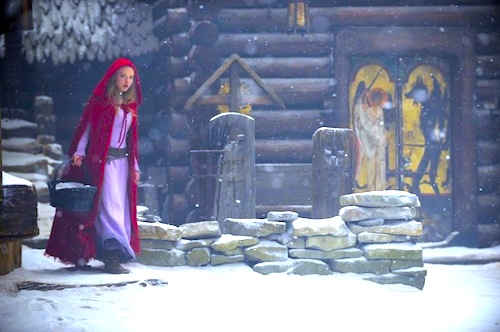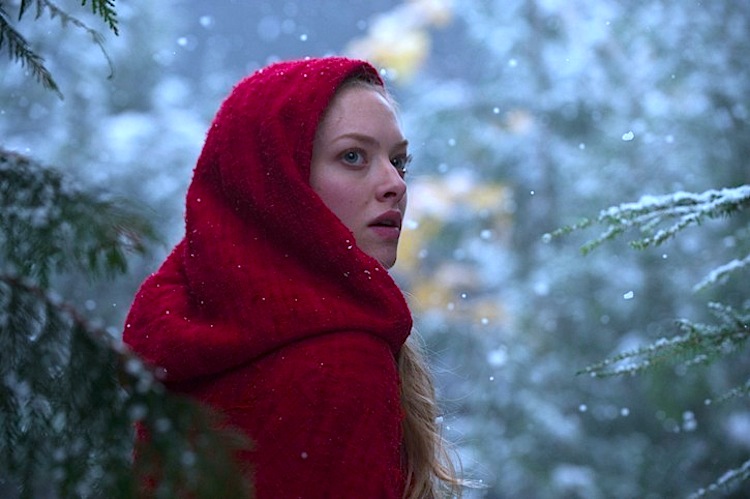By Patricia Ducey. After an interminable two hours, the only mystery left for me to ponder in Red Riding Hood is what compelled actors like Gary Oldman and Amanda Seyfried to sign on to this dull, unimaginative ‘reimagining’ of the classic fairy tale. I feared intense gore and got a wan, bloodless Lifetime movie instead.
The story is set in a mythical village that is straight out of a Charles Kinkade canvas. A former production designer, Hardwicke has just phoned the production values in this time. Or perhaps the misty, mythical setting just looks dopey set against the modern tone of the rest of the film. The actors talk like present day folks, except for Oldman, who delivers another scene chewing turn as a Slavic-accented werewolf slayer who rolls into the village with a ride and entourage that would make Diddy jealous. Even Seyfried, whose ethereal pale beauty fills the screen as Valerie, is a mostly modern maiden; her main conflict is which of her two attractive suitors to choose, the poor but hunky woodcutter Peter (Shiloh Fernandez) or the rich but nice boy Henry (Max Irons, son of Jeremy). The Renaissance style costuming completes the awkward mélange of style and tone, which this movie never gets right.

The script tries to add heft to the fairy tale but strangely tosses aside the pheromonic swoon that made Hardwicke’s Twilight movies so successful. Valerie and Peter are pretty tame as star-crossed lovers go; they reveal little of the internal conflict or fevered sexuality of the most successful teen lover tales (see Romeo and Juliet). They’re kind of into each other, but her parents want her to marry Henry, the rich boy. So they plan to run away.
Just then the Big Bad Wolf returns after a long period of laying off the villagers and kills Valerie’s sister. Valerie feels guilty, because her sister loved Henry and was devastated to learn he had been promised to Val. Now we’re getting somewhere: sex, guilt, death!
But no. Valerie gets over it pretty quickly because she has bigger things to worry about: more villagers killed by the wolf, talky visits by the wolf, and then accusations of witchcraft because she talks to the wolf, and villagers being killed by Father Solomon “for the greater good.” Yes, the wolf shows up, kills, then stops and chats telepathically to Valerie. He wants her: come away with me or the town gets it. The wolf is pretty scary when it’s whizzing by with lightning speed killing anything in its path, but once it stops for long conversations with Val we start looking at his strange “fur” and funny little eyes and realize he is one poorly constructed monster. Exposition by puppet: a fatal distraction.
Back to the story, though. Valerie now has to choose again: go with the wolf to save the town or let the killing resume. But as Father Solomon tells them, the wolf is someone among them. Valerie suspects various townsfolk on the basis of their brown eyes— the wolf also has brown eyes—but cannot figure out the mystery. Why does it matter? What is she going to do when she finds out? The movie never answers that question.

***SPOILER ALERT***
Eventually Valerie’s father reveals he is the werewolf and would like her to become one too and join him in the forest. Her father takes an entire scene of lengthy exposition soap opera style to tell us. Finally, Valerie kills Dad and chooses Peter, but her father has bitten Peter, so he becomes a werewolf and leaves the village, fearing he will kill Val or someone he loves. Eventually Valerie ends up with grandma (Julie Christie), living a solitary life in the woods and gazing longingly at the big faux fur wolf who stops by of an evening to make goo-goo eyes at her. Sequel time?
***END OF SPOILERS***
Hollywood gossip suggests that Hood is director Catherine Hardwicke’s revenge on the Twilight producers, who axed her for the sequels after Hardwicke helmed the initial chapter. She hires Twilight Dad Billy Burke as Valerie’s father and seemingly borrows one of their animatronic wolves, but that is where the resemblance ends. Red Riding Hood is not camp enough to be a parody or emotional enough for a teen awakening drama. I would be surprised if the pre-teen set will buy it. Otherwise, there is very little sex or violence and would be a safe afternoon for younger teens.

Funny review Patricia. I was wondering about this film. I like what Catherine Hardwicke did with Twilight, but her work is pretty hit or miss. She had a good cast here and a good premise. I think the problem is when Hollywood tries to make movies set in the past but puts in too much contemporary style.
How do people feel about the story of “Little Red Riding Hood” being turned into a teen romance in the first place? Isn’t this supposed to be a story for little kids?
Well, at least it isn’t blatantly sexual or violent, so I don’t mind that they used the fairy tale. It’s just not scary, and the fairy tale was!
If they were going to use a modern tone, they should have injected some humor, like in a Knight’s Tale. My two cents.
Thanks for the comments.
Do you mean Thomas Kinkade, the painter of cutesy pictures of rustic cottages with the windows lit in a way described by Joan Didion as looking “as if the interior of the structure might be on fire”?
Yes! Thanks.